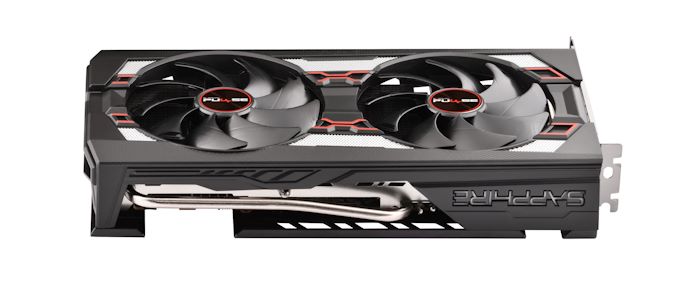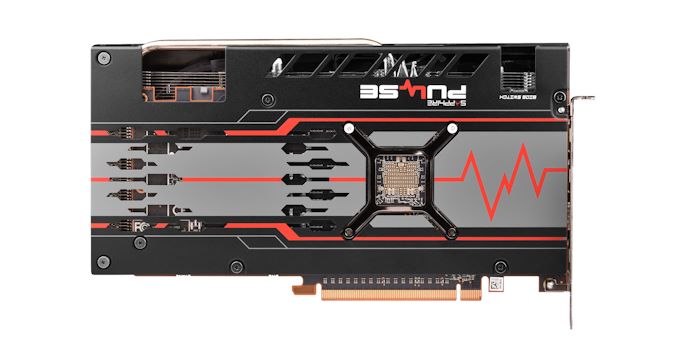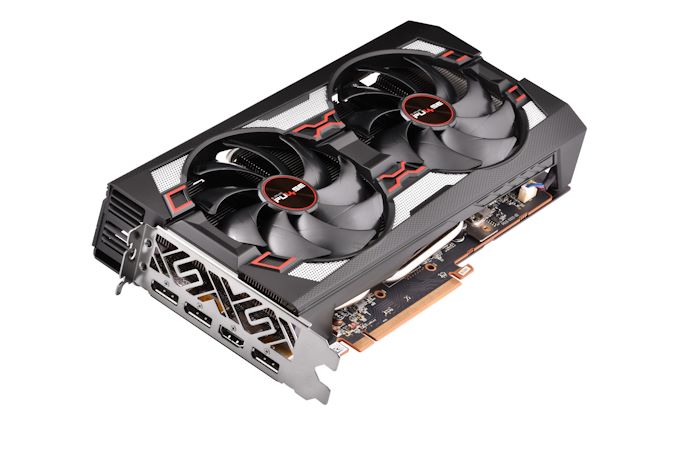The AMD Radeon RX 5600 XT Review, Feat. Sapphire Pulse: A New Challenger For Mainstream Gaming
by Ryan Smith on January 21, 2020 9:01 AM ESTMeet the Sapphire Pulse Radeon RX 5600 XT
Shifting gears, let’s talk about the actual hardware that will be hitting retail shelves today. As I mentioned towards the start of the article, AMD isn’t launching an official reference RX 5600 XT, so today’s launch is all about partner cards. To that end, AMD has sampled us with Sapphire’s Pulse RX 5600 XT. Sapphire’s card is a moderately factory overclocked card, and following AMD’s BIOS changes, is apparently a good example of what AMD wants other partner factory overclocked cards to be like.
| Radeon RX 5600 XT Card Comparison | |||||
| Radeon RX 5600 XT (Reference Specification) |
Sapphire Pulse RX 5600 XT (Quiet Mode) |
Sapphire Pulse RX 5500 XT (Default/Perf Mode) |
|||
| Base Clock | 1290MHz? | 1290MHz | 1290MHz | ||
| Game Clock | 1375MHz | 1460MHz | 1615MHz | ||
| Boost Clock | 1560MHz | 1620MHz | 1750MHz | ||
| Memory Clock | 12Gbps GDDR6 | 12Gbps GDDR6 | 14Gbps GDDR6 | ||
| VRAM | 6GB | 6GB | 6GB | ||
| TBP | 150W | ~150W | ~180W | ||
| GPU Power Limit (TGP) | N/A | 135W | 160W | ||
| Length | N/A | 10-inches | |||
| Width | N/A | 2.3-Slot | |||
| Cooler Type | N/A | Open Air, Dual Fan | |||
| Price | $279 | $289 | |||
Editor's Note: These are the specs post-BIOS update. Anyone buying the Pulse in January will want to make sure to update their card with Sapphire’s new BIOSes
Sapphire has several sub-brands of cards, including the Nitro and the Pulse. Normally the Nitro cards are their higher-priced factory overclocked cards, while the Pulse cards are more straightforward. But following AMD’s BIOS changes, that seems to have at least partially gone out the window. In any case, even with its factory overclock the Sapphire Pulse RX 5600 XT is not being positioned as a high-end card among RX 5600 XTs; at $289, it carries just a $10 premium over AMD’s MSRP.
For their Pulse RX 5600 XT cards, Sapphire has opted to factory overclock both modes for the card. The card’s default mode, which is its performance mode, ships with a ~180W TBP. This affords a rather sizable 240MHz (17%) increase in the card’s rated game clock. Meanwhile the memory clock has been increased by 2Gbps (17%) to 14Gbps. In short, in performance mode the Pulse is noticeably more powerful (and power-hungry) than a baseline RX 5600 XT.
On the flip side of the coin is the card’s quiet mode BIOS. This BIOS uses settings much closer to AMD’s own reference specs, with the 150W TBP and 12Gbps matching AMD’s. The only change here is that the card gets a milder 85MHz (6%) factory overclock, as far as the game clock is concerned.
Digging into the card, it’s clear from the start that Sapphire has overbuilt the card, particularly for cooling performance. At 10-inches long the card isn’t especially lengthy, but Sapphire makes up for that with a 2.3-slot wide cooler design and significantly taller (5.3-inch) frame. Comparing it to NVIDIA’s relatively compact dual-fan GeForce RTX 2060 Founders Edition, the Sapphire Pulse RX 5660 XT has about 50% more volume. Which, along with making the card a bit of a pain to install, affords it a lot more volume for heatsinks and fans.
The payoff for this oversized design is that Sapphire can use larger, lower RPM fans to minimize the fan noise. The Pulse 5600 XT packs 2 95mm fans, which in our testing never got past 1150 RPM. And even then, the card supports zero fan speed idle, so the fans aren’t even on until the card is running a real workload and starts warming up. The net result is that the already very quiet card is completely silent when it’s idling.
Meanwhile beneath the fans is a similarly oversized heatsink, which runs basically the entire length and most of the height of the board. A trio of heatpipes runs from the core to various points on the heatsink, helping to draw heat away from the GPU and thermal pad-attached GDDR6 memory. The fins are arranged horizontally, so the card tends to push air out via its I/O bracket as well as towards the front of a system. The card also comes with a metal backplate – no doubt needed to hold the oversized cooler together – with some venting that allows air to flow through the heatsink and out the back of the card.
Feeding the beast is an 8-pin external PCIe power cable, as well as PCIe slot power for its electricity needs. From a practical perspective this is well-provisioned for a card that will hit 180W, and with the design presumably being recycled from a 5700 series design, there’s room for a second power connector if Sapphire ever needed it.
Finally for hardware features, for display I/O we’re looking at a pretty typical quad port setup. Sapphire has equipped the card with 3x DisplayPort 1.4 outputs, as well as an HDMI 2.0b output. With daisy chaining or MST splitters, it’s possible to drive up to 6 monitors from the card.














202 Comments
View All Comments
maroon1 - Tuesday, January 21, 2020 - link
It does not beat RTX 2060 (after price drop) in performance per dollar while having less features. 5600XT does not sound like great value. 5500XT 8GB is even worseQasar - Tuesday, January 21, 2020 - link
but if one puts no value in those features, then what?? i dont consider RT value feature, as i wont use it, i dont play any games that use it, so why waste the money on it ( for now ) as was said in another reply, unless you get a higher end 2070 or better, the performance hit for it, makes it almost unusablesing_electric - Tuesday, January 21, 2020 - link
Especially since the 2060 is BARELY capable of RTX stuff with current-gen titles. By the time the 1st titles developed with accelerated ray tracing in mind - rather than an "add on" after a lot of the art was made and the engine was written - come out (next year?), there's a good chance the 2060 will be too slow to enable rays anyways.neblogai - Tuesday, January 21, 2020 - link
As per Hardware Unboxed review- 5600XT offers the same speed as 2060, but costs less and uses less power.maroon1 - Tuesday, January 21, 2020 - link
RTX 2060 matches 5600XT in performance per dollar without any of these features. SO even if these "extra" features are useless, 5600XT does not have any advantage anyway.I rather have RT for safety as some games in future might become RT only since next gen consoles are going RT.
DLSS runs very on wolfenstein youngblood (check digital foundary about it)
ALso, it support variable rate shading which is also supported by next gen console (at least xbox series x confirmed to use it)
Cooe - Tuesday, January 21, 2020 - link
"as some games in future might become RT only". And that's what where I realized that you have absolutely no freaking clue what in the hell you are talking about.Xyler94 - Tuesday, January 21, 2020 - link
Do you understand how computationally demanding drawing an entire scene in Ray Tracing would be?Every game today that has Ray Tracing uses it only for shadows or reflections, because anything else it would hurt performance too much. RT is amazing, and I love it... but when some of the best computer hardware takes a few days to render an image completely in RT, I don't think an RTX2060 would stand any chance at rendering an image in full RT in a second, let alone render 60 images in a second...
Remember, games needed to cut down on the amount of Rays and bounces just to get acceptable RT performance. Rendering everything in RT would require a ton of bounces to get a better image than traditional rasterization... and it's the bouncing that makes RT so computational taxing. I refer to it as bouncing, because the rays bounce off objects to create realistic shadows, lighting, and textures on objects. The more rays, and bounces you have before it goes to the "eye", the better the image is gonna look.
TL;DR: Don't hold your breath. By the time games can be fully rendered in RT, I'm guessing we'll be on the 4th or 5th generation of RT Cards from both Nvidia and AMD...
BenSkywalker - Tuesday, January 21, 2020 - link
Metro Exodus uses ray tracing for global illumination and Q2RTX uses ray tracing for GI, shadows and reflections, both playable on a 2060. I've played through those games with ray tracing on a 2060 without issue, people say Control is also, but don't have first hand experience with that(and not sure exactly what rt is used for).There are hardly any games is valid, but there are games and they are quite playable on a 2060 using ray tracing today.
Droekath - Wednesday, January 22, 2020 - link
Ray tracing on the 2060 is rather pointless, unless you want to play games at sub-30 fps on most modern titles at 1080p. If you really want to apply ray tracing, then it's advisable to get at least a 2070 or higher.maroon1 - Tuesday, January 21, 2020 - link
According to Hardware Unboxed 2060 is slightly faster. And it offer comparable performance per dollar (if 2060 is 299 dollar)